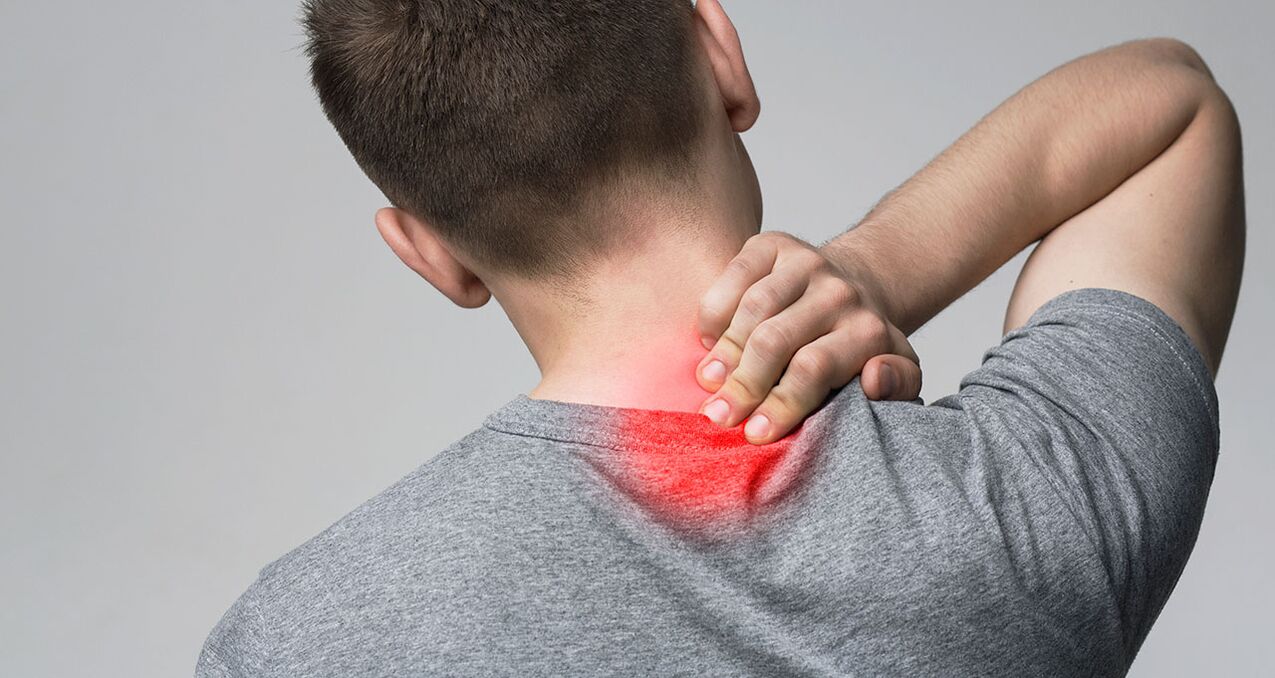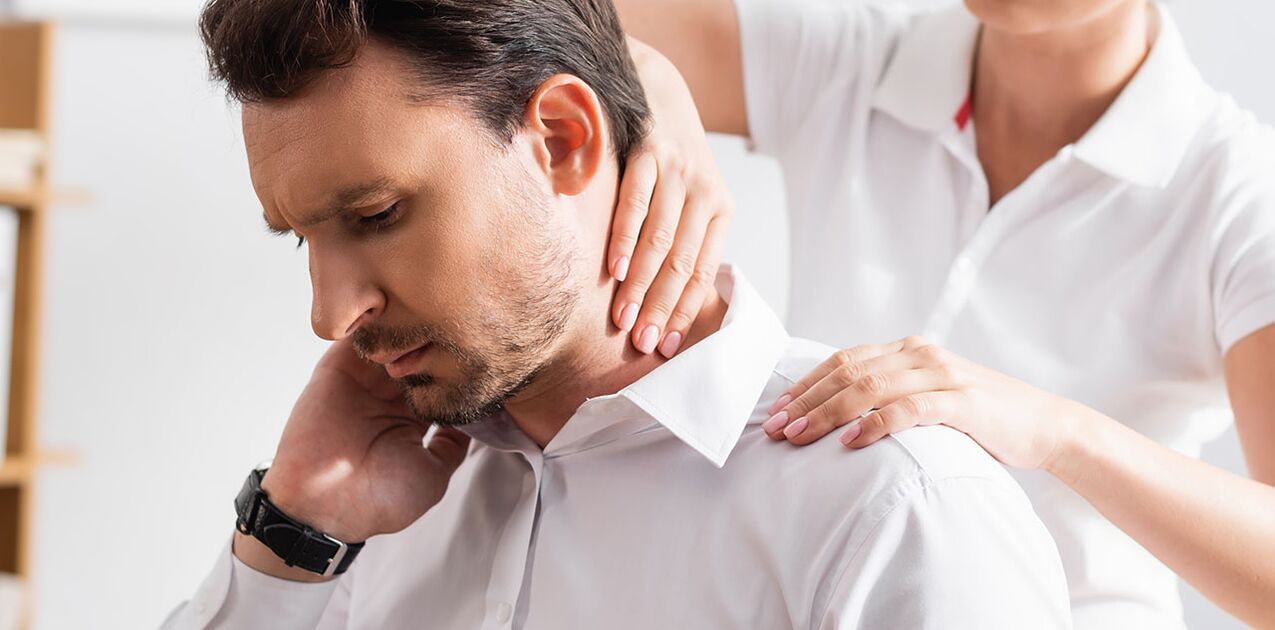
Almost two-thirds of people experience neck pain (cervicalgia). Causes include acute conditions such as muscle strains and whiplash, and chronic conditions such as cervical spondylosis and myofascial pain syndrome. Pinched nerves, infections, broken bones, and spinal cord problems can also cause neck pain.
For effective treatment, it is necessary to understand the cause of neck pain. For this, a comprehensive examination is conducted. Based on the diagnostic results obtained, the doctor prescribes therapy. You can not self-medicate, because many cases cannot be delayed. Pain that seems harmless at first glance can cause serious complications.

general characteristics
The neck is a sensitive area of the body - the cervical spine consists of seven vertebrae. Muscles, ligaments and nerves provide stability - the muscular skeleton. Poor posture or excessive tension causes overload, which reduces blood flow, causing muscle pain and myositis (inflammation).
Rarely, neck pain is felt locally. Often it spreads to the shoulders, sometimes to the arms, even to the fingers. It may be felt in the back of the head, causing headaches, dizziness, and vision problems. When the neck is stiff, turning and tilting the head becomes difficult and is accompanied by severe discomfort.
Pain in the neck area varies in nature and severity. Numbness of the hands or back of the head, hyperemia and swelling of the skin may occur. Discomfort can be short-term or long-lasting, making daily activities difficult.
Acute neck pain usually goes away within a few days to 2 weeks and is nothing to worry about. Neck pain is considered chronic if it lasts more than three months. If, along with neck pain, symptoms appear that are different from those mentioned, for example, nausea, vomiting, sensitivity to light, fever, chills, nervous disorders, symptoms of paralysis, etc. , you should see a doctor.
Types of neck pain
Depending on the nature, neck pain can be non-specific and specific. In the first case, we are talking about discomfort, the obvious cause of which is not present. Often it occurs due to overstrain of the trapezius muscle. Specific pain has a specific cause related to a specific disease.
Depending on the period, there are:
- Acute cervix - lasts no more than 10 days, disappears after the elimination of the provoking factor.
- Chronic cervicgia - persistent for more than three weeks, recurrent or continuous.
According to the etiopathogenetic classification, vertebrogenic and non-vertebrogenic pain in the neck area are distinguished. In the first case, we are talking about a primary lesion of the osteochondral structure of the cervical vertebral region. It develops against the background of spondylogenic and discogenic cervix due to compression of the spinal cord, damage to the bone structure and deformation of the intervertebral disc.
According to the area of localization, pain syndromes are distinguished in the anterior, posterior and lateral regions of the neck. Each of them has a specific cause. Accordingly, each case requires the appointment of an individual treatment plan.

Causes of neck pain
Most neck pain is non-specific. This means that the doctor cannot determine a specific medical cause for the complaint, such as an injury to the intervertebral disc or vertebrae. Often discomfort occurs as a result of incorrect posture, which leads to muscle-fascial tension.
Neck pain occurs for the following reasons:
- sit for a long time in front of the computer;
- too much work, for example, during sports or physical work;
- underdeveloped muscles;
- increased muscle tone;
- hypothermia, exposure to drafts;
- incorrect position during sleep;
- accident (whiplash, cervical spine injury);
- degenerative-dystrophic changes in the spine;
- colds and viral infections;
- changes in hormones during menopause;
- stress, depression and anxiety;
- mineral deficiency.
Quite rarely, pain in the neck is a symptom of inflammation or damage to the cervical spine. The most common cause is excessive musculofascial tension in the shoulder area. After a few days, the complaint usually disappears on its own. If the discomfort persists longer, becomes chronic, or additional symptoms appear, consultation with a specialist is necessary.
Pain in the front of the neck: causes
Discomfort of varying severity is felt on the front surface of the neck. There are many structures here, each of which can cause pain. It is not easy to determine the exact cause without a comprehensive diagnosis.
Causes of neck pain in the front are:
- Diseases of the thyroid gland (toxic goiter, Hashimoto's thyroiditis) - discomfort occurs as a result of inflammatory processes and endocrine pathology. Increased pain is observed when bending forward and during movement. Accompanied by increased temperature, increased heart rate, feeling hot and increased sweating.
- Sialadenitis is damage to the salivary glands of the jaw. Pain develops with swallowing, chewing movements, and turning the head. Accompanied by the formation of swelling and compaction. Characterized by dry mouth and difficulty eating. It occurs with weakness, chills and fever.
- Purulent inflammation in the pharynx - the inflammatory process spreads to adjacent tissues, which leads to the formation of a retropharyngeal abscess. The discomfort is accompanied by redness of the skin on the front of the neck, which becomes bright pink and hot to the touch. The pain is throbbing and intense, so the patient may refuse to eat. Related to high fever. It is the result of an extensive paratonsillar abscess.
- Cervical plexitis - the intensity of clinical manifestations depends on the number of damaged nerve structures. Often, sharp pain occurs from the anterolateral side of the neck. There is difficulty coughing and speaking. Discomfort radiates to the ears, chest and back of the head. There is a feeling of "crawling" and paresthesia. Occurs as a result of injury, hypothermia or after vaccination.
- Rheumatic disease is a systemic disorder of connective tissue (collagenosis) with damage to the skin and muscles. Dermatomyositis and scleroderma are characterized by constant pain and bothersome pain. Swelling and thickening of the skin occurs. Shooting pains radiate to the front of the neck and spine.
- Lymphadenitis - localized discomfort in the upper neck. Affected lymphoid tissue. Discomfort is localized in the submandibular area, usually on one side. Symptoms develop with tilting the head and talking. Hyperemic and swollen skin. Accompanied by inflammation of the lymph nodes, general weakness, and fever.
Pain in the front of the neck can also occur with an atypical attack of angina. The pain is more pronounced and accompanied by shortness of breath. It becomes difficult to speak and there is difficulty swallowing.
Localized pain in the front also with inflammation of the mucous membrane of the trachea and esophagus. Discomfort is the result of a painful cough and tracheitis. Less common causes include cervical compression syndrome and spinal cord lesions.
Pain in the back of the neck: causes
Discomfort in the back of the neck is a result of prolonged work at the computer and a low level of physical activity. Pain occurs as a result of pathological changes in the spinal column.
Pain in the back of the neck has the following causes:
- Osteochondrosis is accompanied by degenerative-dystrophic disorders of the intervertebral discs, a decrease in their strength and a decrease in height.
- Protrusions are a complication of osteochondrosis, accompanied by the protrusion of the intervertebral disc. Protrusion is caused by a violation of the vertebral artery and nerve structure.
- Intervertebral hernia occurs when the protrusion progresses. The internal contents of the intervertebral disc protrude into the spinal canal, compressing the nerve endings.
- Spondylosis - bony protrusions (osteophytes) appear on the edge of the vertebral body, while the intervertebral disc decreases in size, the adjacent vertebrae fuse, and neck mobility is limited.
Pain in the back of the neck is characteristic of myofascial syndrome, where individual muscle spasms. Accompanied by acute pain when pressing on the back of the neck, as well as during physical activity.
Among systemic diseases, one can distinguish ankylosing spondylitis, which affects the articular structure and is characterized by limited mobility. Accompanied by the formation of a permanent and durable conglomerate due to the fusion of individual vertebrae with each other. Less commonly, pain in the back of the neck is associated with spinal tuberculosis, Reiter's syndrome and osteomyelitis.
A more serious cause that requires emergency medical attention is a compression fracture of the spine. Occurs as a result of whiplash injury to the neck.
Side neck pain: causes
Pain in the neck can be throbbing, tingling or burning. It radiates to the shoulder or ear. Accompanied by the formation of secondary torticollis. This causes the head to tilt towards the affected side. Especially atherosclerosis and other blood vessel disorders.
The cause is also muscle spasms that occur during sudden movements, excessive stress and hypothermia. Pain in the side of the neck is observed with malignant processes in the larynx, pharynx and thyroid gland. You shouldn't leave it to chance. If the main symptoms appear, you need to see a doctor. This approach allows you to take timely treatment measures and eliminate the development of complications.
Diagnosis of the cause of neck pain
The examination includes laboratory examinations and instrumental diagnostics aimed at describing the affected area and identifying pathological signs:
- Ultrasound of the submandibular salivary gland and thyroid gland - prescribed for rapid visualization of cervical structures and identification of diseases of internal organs that cause neck pain. Duplex scanning is performed to scan the large vessels and determine the state of blood flow.
- X-ray or CT (computed tomography) examination - determines the displacement of the vertebrae and the deformation of the bones. Allows you to determine the degree of vertebral disruption and the nature of the disruption.
- Functional diagnostics - damage to the muscular system is determined using MRI of the cervical spine.
Blood tests are done to confirm the inflammatory process. Thyroid hormone levels are also determined. If general infectious symptoms are present, a bacteriological culture or throat swab is prescribed. Serological tests (PCR, ELISA, RIF) are also required.

Treatment for neck pain
For neck pain, conservative treatment methods are prescribed instead of surgery. Drug treatment aims to relieve pain, eliminate the cause of discomfort and restore the body. Therapy is prescribed depending on the stage of the pathology, the cause of the disorder, the age and characteristics of the patient's body.
To increase the effectiveness of the drugs used, physical therapy and physiotherapy are prescribed. Manual techniques are effective. In some cases, if the expected results are not achieved, surgery is performed.
Help before diagnosis
Tilting and rotating the head, as well as light massage, will help relieve acute neck pain. The tension gradually subsided, which helped to improve the situation. There are muscle knots or trigger points in the neck muscles that cause discomfort when irritated. Rubbing and kneading gently helps relieve pain.
In the first 24 hours after the discomfort occurs, you can use cold or warm compresses. Warming your neck with a heating pad is only allowed from the side or back.
Tablets and ointments for neck pain
It is recommended to take any analgesic medication that temporarily improves the condition. NSAIDs are prescribed, which not only relieve pain, but also have an anti-inflammatory effect.
For a local effect, you can use a heating patch or ointment. They relieve hyperemia and swelling, which reduces pressure on nerve endings and reduces spasms.
Exercises for neck pain
For moderate pain, you can do light gymnastic exercises on your own. It is important to monitor your well-being so as not to cause harm.
Smooth, non-sharp movements will help reduce discomfort:
- lie on your back, press your head on a flat, but not soft pillow until the count of 5 (from 5 to 7 approaches);
- lie on your side, lift your head and hold until the count of 5 (at least 5 approaches);
- lie on your stomach, cross your hands behind your head, lift your head, give light resistance (from 4 to 6 approaches).
In cases of acute and severe pain, any exercise is contraindicated. You should stop exercising if you feel dizzy or weak. In this case, the Shants collar will help reduce the pain. Immobilization should not be prolonged. Otherwise, the muscle corset will weaken and the situation will get worse.
What not to do if you have neck pain
If discomfort often occurs in the cervical spine, it is unacceptable to:
- Maintaining a forced body position for a long time, where the neck is in a tense state.
- Lift heavy objects and do physical work.
- Exposed to severe stress, which causes vasospasm, which negatively affects blood circulation.
- Frequent drinking of alcohol and smoking, which contribute to the continuous narrowing of the vascular structure.
- Dress inappropriately for the weather, stay out of drafts, and don't wear hats or scarves during winter.
It is unacceptable to sleep on soft mattresses and high pillows. It is necessary to avoid a sudden turn of the head, which can cause a sudden pinch of the nerve.
When you need to see a doctor immediately
Specialist help is necessary if the pain does not decrease after 5-7 days or intensifies. You should see a doctor if you have severe pain that prevents you from sleeping and does not go away when you change your body position.
An absolute indication for a visit to the clinic is a deterioration in general health - the appearance of nausea, dizziness and weakness. Hand numbness also requires professional help.

Drug treatment
Combination therapy is usually prescribed, which includes:
- non-steroidal anti-inflammatory drugs - relieve discomfort and swelling, eliminate residual inflammation;
- analgesics - relieve pain and improve the general condition, but do not eliminate the cause;
- corticosteroids - reduce inflammation, affect muscle relaxation;
- muscle relaxants - relieve painful muscle tension, increase motor activity.
If the pain is severe, an injection to the trigger point is indicated. Antioxidants, anticonvulsants and antidepressants are also prescribed.
Chondroprotectors stop inflammation and degenerative processes in the spine. Vitamins improve blood circulation and have a healing effect.
Surgery
Surgery is performed to restore the function of the cervical spine. The most commonly used decompression tactic is indicated for compression syndrome, when the nerve root is compressed by a pathological defect. Microsurgical discectomy, laminectomy, and nucleoplasty are used. Also, for pain in the cervical spine, stabilization techniques are popular - arthrodesis, vertebroplasty, implantation of bone tissue fragments and installation of fixed metal structures.
Surgical intervention aims to eliminate the cause (hernia, tumor, osteophyte, etc. ). The purpose of the operation is to restore the motor support function of the spine. After surgical treatment, long-term rehabilitation is required, which is necessary to prevent various complications, which are not common. The results of the operation depend on the timeliness of the procedure and compliance with medical recommendations for recovery.
Manual therapy
Minimally invasive techniques involve the use of manual techniques. Effectiveness is aimed at joint structures, muscles, ligament-articular and bones. Manual therapy improves conditions of spinal hernia, poor posture, protrusion, and osteochondrosis. Improves neck pain.
A course of manual therapy restores mobility, restores damaged tissues, and relieves dizziness. The pain gradually decreases, the muscles of the back and neck relax. The patient's well-being improves.
Physiotherapy
Physiotherapy treatment is aimed at the influence of magnetic fields, electric currents, temperature and mechanical effects on the body. The procedure is painless, does not cause adverse reactions or complications if you follow the doctor's recommendations. Physiotherapy is indicated for the treatment of chronic diseases and prescribed for preventive purposes. Used to strengthen the immune system, treat chronic inflammation, and improve posture. The procedure increases the effectiveness of the drug.
Physiotherapy treatments for neck pain include:
- SMT (sinusoidal modulated current) - stimulates the production of biologically active substances in the body. Electrophoresis relieves pain and restores mobility, activating your own defenses. The procedure complex allows you to achieve a clear and long-lasting analgesic effect, complemented by anti-inflammatory and anti-edema effects.
- MLT (magnetic field and laser beam) – provides a significant therapeutic effect. This procedure aims to activate certain enzymes, change capillary osmotic pressure and improve blood circulation.
- UVT (shock wave therapy) - with the help of low-frequency acoustic waves, a process is launched that improves microcirculation. Inflammation is reduced, swelling is eliminated and pain is reduced.
To achieve a clear effect, it is recommended to undergo a course of physiotherapeutic procedures. Improvement, as a rule, is observed after the first session. Physiotherapy is contraindicated in acute inflammation. It is prescribed when the process is chronic and in the recovery phase.
Exercise therapy
Therapeutic physical culture aims to create a neck muscle framework, relieve tension and restore blood circulation. An individual approach is used for each patient, taking into account his abilities and needs.
A physical therapy program is prepared by the doctor, taking into account the medical history and contraindications. If necessary, adjustments are made to it taking into account the dynamics of the patient's condition, which eliminates the development of complications and allows you to obtain the expected results.
When starting a set of exercises, it is important to consider:
- the main task is to tighten the muscles, they need to be made elastic;
- it is important to make movements smoothly, because sharp and fast movements will only worsen the situation;
- Exercise should be done on a flat surface using special mats and rollers.
It is important to observe regularity and frequency. If discomfort occurs, you need to reduce the load.
Exercises to restore the plasticity of the muscle structure and increase the mobility of the vertebrae:
- Exercise No. 1 – Turn your head to the right, then to the left. Provides mobility of the cervical vertebrae.
- Exercise No. 2 – Tilt your head down, press your chin to your chest so you can feel the chest cavity. This exercise improves neck mobility and relieves muscle spasms.
- Exercise No. 3 – Move your head back, pull your chin back. Exercise improves posture in the cervical spine.
A set of exercises has also been developed to strengthen weak muscles to create a muscle corset and reduce pain. While sitting, place your hands on your forehead and tilt your head forward to create resistance. You can also do a similar tilt to the right and left.
Which doctor should I contact for neck pain?
If discomfort occurs, you should visit a therapist. Based on the complaint, the general practitioner will prescribe an examination and, if necessary, refer you to a specialist - neurologist, endocrinologist or oncologist.

conclusion
Between 30 and 70% of the population suffers from neck pain. These problems reduce quality of life and often lead to disability. With timely consultation with a doctor and treatment, the prognosis is usually favorable.
Therapy for neck pain includes physical, behavioral and pharmacological methods. The most effective are therapeutic exercises, manual therapy, proper organization of the workspace and compliance with ergonomic rules. NSAIDs, injections and antidepressants are prescribed. In advanced cases and when conservative treatment is ineffective, surgery is performed.


















